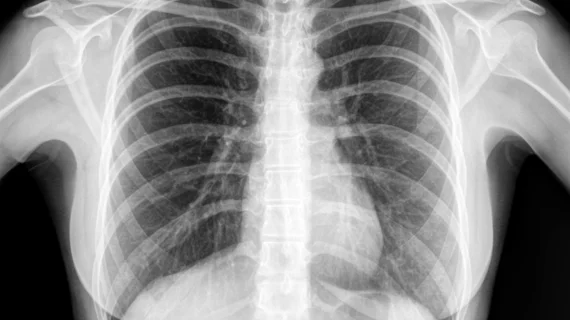AI predicts long-term mortality from single chest x-ray
A deep learning software identified patients at an increased risk of long-term mortality based on data from a single chest radiograph, reported researchers of a new study published in JAMA Network Open.
Nicknamed CXR-risk, the software was tested on screening x-ray data from the Prostate, Lung, Colorectal and Ovarian Cancer Screening Trial (PLCO) along with imaging data from the National Lung Screening Trial (NLST) to produce a mortality risk score.
In the PLCO data, patients with a high risk-score had a 53% mortality rate at 12 years compared to 34% at 6 years in the NLST dataset, reported Michael T. Lu, MD, MPH, of Massachusetts General Hospital and Harvard Medical School in Boston, and colleagues. Those rates were 18- and 15-fold higher compared to patients in the very low-risk category.
The clinical implications of a platform like CXR-risk are still unknown, Lu et al. wrote, but the researchers believe it could eventually help “inform decisions about lifestyle, screening, and prevention.” And when applied to populations, Lu and colleagues suggested identifying patients who may be at higher risk could help health systems become more economical with their resources.
It is difficult for radiologists to know which imaging features have long-term prognostic value, the researchers explained. Traditionally, the only way to do this is to “hypothesize that an individual finding has value, manually assess the finding, and test its association with the outcome,” they added. Deep learning has shown promise in automating this issue, but its application to long-term prognoses hasn’t been as widely studied.
With this in mind, the team developed CXR-risk using 41,856 chest x-rays from the PLCO dataset and tested their software on another 10,464 images from that set; PLCO includes asymptomatic nonsmokers and smokers (aged 55-74 years) enrolled at 10 U.S. sites from Nov. 8, 1993, through July 2, 2001. The software was then tested on 5,493 chest radiographs from the NLST dataset which consists of heavy smokers (aged 55-74) from 21 U.S. sites from August. 2002 through April 2004.
Overall, the CXR-risk area under the receiver operating characteristic curve (AUC) score was 0.75 for 12-year mortality in the PLCO dataset and 0.68 for 6-year mortality in the NLST set.
In each dataset, prognostic value was “complementary” to the radiologists’ diagnostic findings—lung nodules, for example—as well as standard risk factors (age, sex and diabetes). The CXR-risk score was also independently associated with lung cancer death (adjusted hazard ratio (HR), 11.1 and 8.4), as well as noncancer cardiovascular (aHR, 3.6 and 47.8) and respiratory (aHR, 27.5 and 31.9) death in both PLCO and NLST test data sets, respectively.
“The CXR-risk score took as input the radiograph only. This was intended to prove a point—that a CNN can extract prognostic information embedded in the image, without any other demographic or clinical information,” the authors concluded. “Future deep learning models that incorporate this additional information, including age, sex, other risk factors, blood biomarkers, other imaging and nonimaging tests, and change over time will likely have greater prognostic value.”

